The government has acknowledged the country’s vulnerability to climate change and natural hazards in the National Development Plan 2019/20 to 2021/22, specially the increasing frequency and intensity of droughts, having established the improvement of national and community resilience to Natural Disasters as a goal.
The National Disaster Management Agency is the leading institution for DRR. Additionally, the institutional framework for DRR includes: The Ministerial Disaster Management Team; the National Disaster Management Council; the Regional Disaster Management Committee; the Emergency Management Structures. Eswatini has, since 2010, a multi-stakeholder National Climate Change Committee (NCCC) to ensure effective coordination across sectors, and responsible for coordinating relevant stakeholders in guiding climate change initiatives. The committee is composed by government ministries and departments, private sector, CSOs and academics.
Regarding DRR framework, the country has the Disaster Management Act, 2006; and Strengthening National and Local Resilience to Disaster Risks in Swaziland (UNDP Project Brief; 2008). The main instrument governing is the National Climate Change Policy (2016), aimed at enhancing synergies in the implementation of the 3 Rio Conventions (UN Framework Convention on Climate Change, the Convention on Biological Diversity and the Convention to Combat Desertification.
In Eswatini, a small country bordering South Africa and Mozambique, mountainous in the west and hilly in the east, the climate varies mainly with altitude. Throughout the country, there is a rainy season from mid-October to mid-April and a dry season from mid-April to mid-October, but in the western area, where the altitude is higher, rainfall is more abundant. The rains occur primarily as showers or thunderstorms in the afternoon. The austral winter is dry and sunny everywhere.
The altitude determines three areas with different climates and environments: Highveld, Middle Veld and Lowveld.
In the west, we find the Highveld, crossed by the Drakensberg Mountains, at an altitude between 800 and 1,800 meters. Here, the climate is temperate, with cold nights in winter. Being that it's a humid area, we find forests, rivers and waterfalls. In summer, it can sometimes get hot during the day, but nights remain cool, while in winter, the night temperature can drop below freezing (0°C). The rainfall amounts to 1,000/2,000 millimeters per year.
The Middle Veld lies in the center of the country, between 400 and 800 meters above sea level. Here, the temperature is slightly higher: in winter, the weather is pleasant during the day, it gets cold at night but the risk of frost is lower. On the contrary, summer is hot, sometimes very hot, with peaks near 40°C.
The Lowveld is found in the east, between 100 and 400 meters, and it's characterized by a warmer climate and a landscape dominated by the savannah. During winter, nights can be cold, with a wide daily temperature range. Summer is humid and uncomfortably hot. Rainfall in the Lowveld is even lower, and amounts to around 500/900 mm per year.

Regional Platform / DRR Contact Point
-
Government of EswatiniOrganization type:
Risk reduction Policies, Plans & Strategies
Policies, plans and official statements on disaster risk, climate adaptation and resilience.
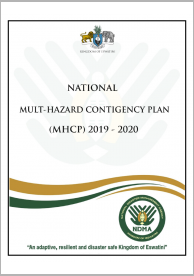
|
National Multi-hazard Contingency Plan 2019-2020
The updated National Multi Hazard Contingency Plan (MHCP) is fundamental for better preparedness at all levels, anticipating potential hazards, response readiness with provision for emergency assistance therefore, minimizes the impact, saves lives and ease sufferings of the affected population. |
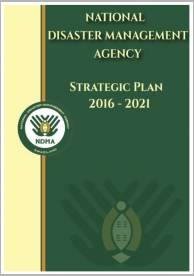
|
National Disaster Management Agency Strategic Plan 2016-2021
This Strategic Plan sets the trajectory of the National Disaster Management Agency for the next five years. |
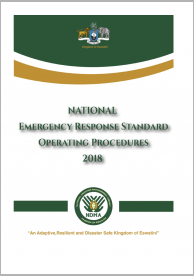
|
National Emergency Response Standard Operating Procedures
The Standard Operating Procedures (SOPs) provide a management structure for emergency response for both small and major emergencies, covering slow and sudden onset hazards. |
Documents & Publications
Disaster risk reduction and resilience publications, reports, research papers and case studies.
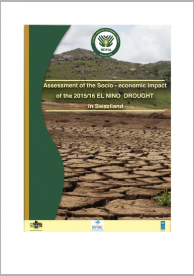
|
Assessment of the Socio-Economic Impact of the 2015/16 El Niño Drought in Swaziland
This report provides detailed findings of an investigation into the socioeconomic impacts of the 2015/16 El Niño drought in Swaziland. |

|
Mid-Term Review on implementing the National Emergency Response Mitigation and Adaptation Plan (2016-2022)
The National Disaster Management Agency (NDMA) commissioned a Mid-Term Review (MTR) in November 2016 supported by the Swaziland UN Country Office focusing primarily on the period beginning from the National Emergency Response Mitigation and Adaptation Plan (NERMAP) launch (February 2016) to Decem |
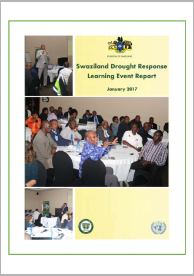
|
Swaziland Drought Response Learning Event Report
The 2015/2016 El Niño induced drought was the worst the country has experienced in over thirty-five years. In 2016, the National Emergency Response Mitigation and Adaptation Plan (NERMAP) 2016-2022 was developed and implemented with success during the response phase of the first year. |
Disaster Data & Statistics
Reports on disaster statistics, country profiles and additional resources on collecting disaster loss data.

|
INFORM Country Risk Profile - Eswatini
Index for Risk Management. |

